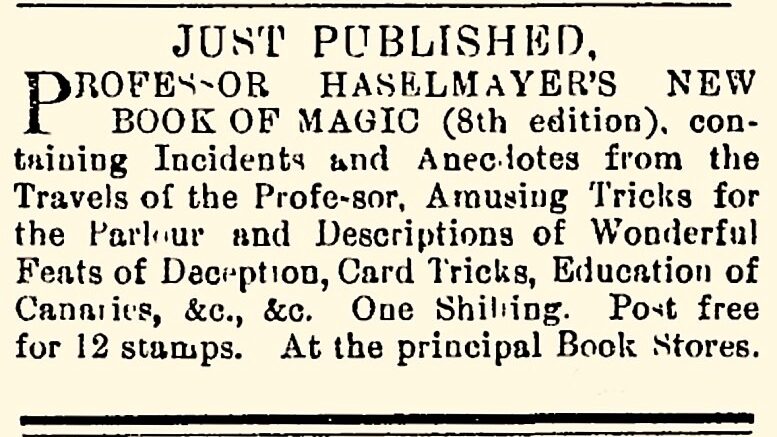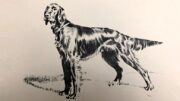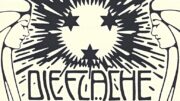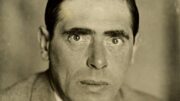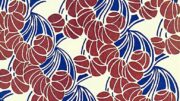One canary is doing a headstand, another seems to be walking around headless, and yet another is in the process of firing a canon. Next to the blast, two other birds have apparently just finished duelling. In more peaceful scenes, one group is sitting politely at a table laid with a tablecloth, a second is travelling around in a carriage, and others are skipping with a long rope.
This quaint flock of feathered friends is assembled on a poster entitled “Haselmayer’s Educated Birds”. The affiche is evidently meant for English-speaking audiences – the trapeze is also flying the stars and stripes of stylised US flags next to balancing acts performed by some other birds.
But why was this poster, which is now stored in the collection at Vienna’s Albertina, printed in Vienna by the renowned Eduard Sieger and based on a design by the Austrian painter Franz Gerasch? And whoever was Haselmayer, whose understanding of winged dressage was clearly remarkable?
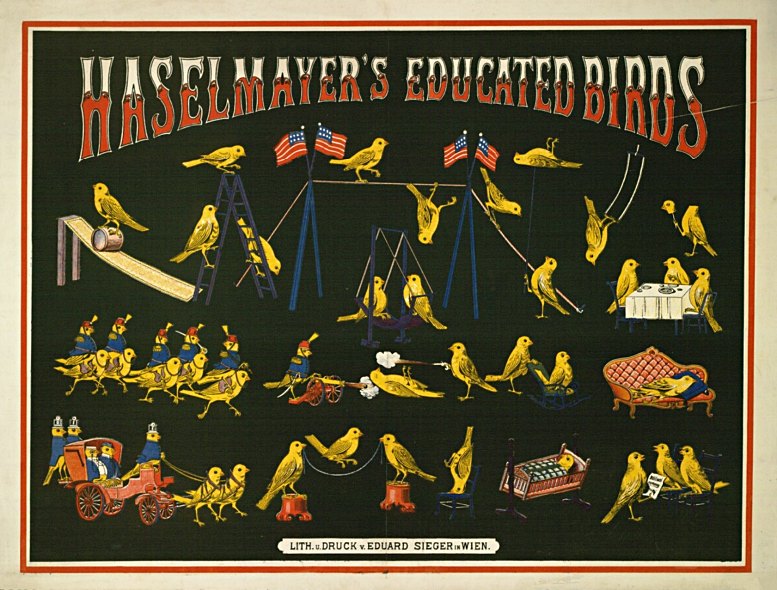
Franz Gerasch: HASELMAYERʼS EDUCATED BIRDS. c.1868. Colour lithograph, Albertina Wien
Early career in Vienna
In a nutshell, Haselmayer was a globetrotting magician. Or as the Canadian newspaper “The Ottawa Free Trader” wrote: “Haselmayer is a magician of the first order, and his trained canaries are wonders.”[1]
Ludwig Haselmayer was born on 18 September 1839 in Atzgersdorf (now part of Vienna).[2] His career began – relatively unspectacularly – in Vienna’s popular entertainment scene. The son of a bookkeeper, he received musical training and played the piano. He was also a virtuoso xylophonist – and he had a pronounced interest in magic. Haselmayer was therefore an ideal performer for “Varry’s Liederspielhalle”. This was not a venue, but rather a group of actors and musicians who presented programmes with a mixed selection of entertainment, organised by the author and actor Anton Varry[3] in taverns and coffeehouses. Their offerings ranged from brief “dramatic jesting” to Viennese songs, polkas and waltzes and even arias from popular operas.
Haselmayer first performed with “Varry’s Liederspielhalle” on 15 August 1860 in the popular Viennese tavern “Zum großen Zeisig” at the “Burg-Glacis” (now Burggasse 2). He performed his own composition, “Ida’s Polka-Mazur”, on the xylophone, which was also known as a “wood and straw instrument” at the time.
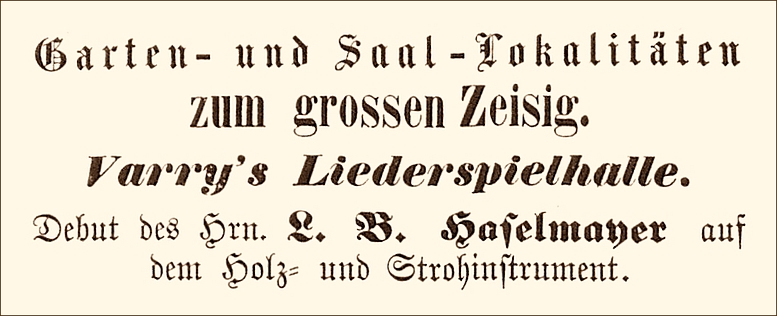
Event announcement in: Der Zwischen-Akt, 15.8.1860, p. 2
Three months later, in November 1860, Haselmayer made his debut as a magician – again at a performance by “Varry’s Liederspielhalle”. He presented two “magic productions” – one of these, entitled “What card would you like?”, seems to have been a card trick. The other was announced in the programme as “Eine Damenspende”, and was possibly a similar magic trick to the one with which he repeatedly amazed his audiences at a later date. He asked a woman in the audience for her wedding ring, and then instructed a member of the audience to hit it with a heavy hammer until it was oval. Then he “conjured” the intact ring out of a sealed envelope.[4]
Assisting Carl Compars Herrmann
The crucial turning point in Haselmayer’s career as a magician came when he was appointed as assistant to one of the most successful international magicians of the day – Carl Compars Herrmann. Born in 1816, Herrmann was originally from Germany and had been living primarily in Vienna since the 1850s. In 1861 he completed a much acclaimed tour of the USA, and when he set off in 1865 for another trip abroad, he took Ludwig Haselmayer with him – whom he had presumably “discovered” at Haselmayer’s appearances in Viennese entertainment venues[5]. The USA tour began on 11 September 1865 at a very prestigious location, the “Academy of Music” in New York, which seated around 4,000 people. Both the evening premiere and also the other (almost daily) performances were extremely successful. “The New York Herald” wrote on its cover on 14 October 1865: “The house was crammed above and below with a fashionable audience, who applauded the wonderful prestidigitateur to the echo. […] There is not on record so great a success as Herrmann has made with his new feasts during the season, which, we regret to say, closes this evening with a final performance at the Academy”.
The “prestidigitateur”[6] – the conjuror – played to full houses and thunderous applause on the other stages of his tour as well. Herrmann and Haselmayer travelled first to Boston and then on to Baltimore. At their performance in Baltimore in November 1865, Ludwig Haselmayer was mentioned by name for the first time in an event announcement, specifically in the German-language newspaper “Baltimore Wecker”. The report not only mentioned Herrmann’s “famous conjuring skills” and the “new, brilliant programme”, but also included the remark: “Herr Haselmayer, assistant to Prof. Herrmann, will also entertain the audience with performances on his famous wood and straw instrument.”[7] In the next issue, the “Baltimore Wecker” added another comment in reference to Haselmayer’s wood and straw instrument: “This instrument, which produces the most beautiful notes in an almost incomprehensible manner when played with wooden sticks, is a highly original combination and deserves to be seen and heard.”[8]
The Professor and his “stylocarfe
Ludwig Haselmayer received his first publicity for playing the xylophone – and he was able to use this to his best advantage. When the tour of the USA with Carl Compars Herrmann came to an end, he turned his attention to developing his own programmes, and music was a central element. He also “internationalised” his first name, changing it from Ludwig to Louis, and began calling himself Professor (this title was very popular with magicians – Compars Herrmann also operated under the name of Professor, as did numerous other magicians at the time).
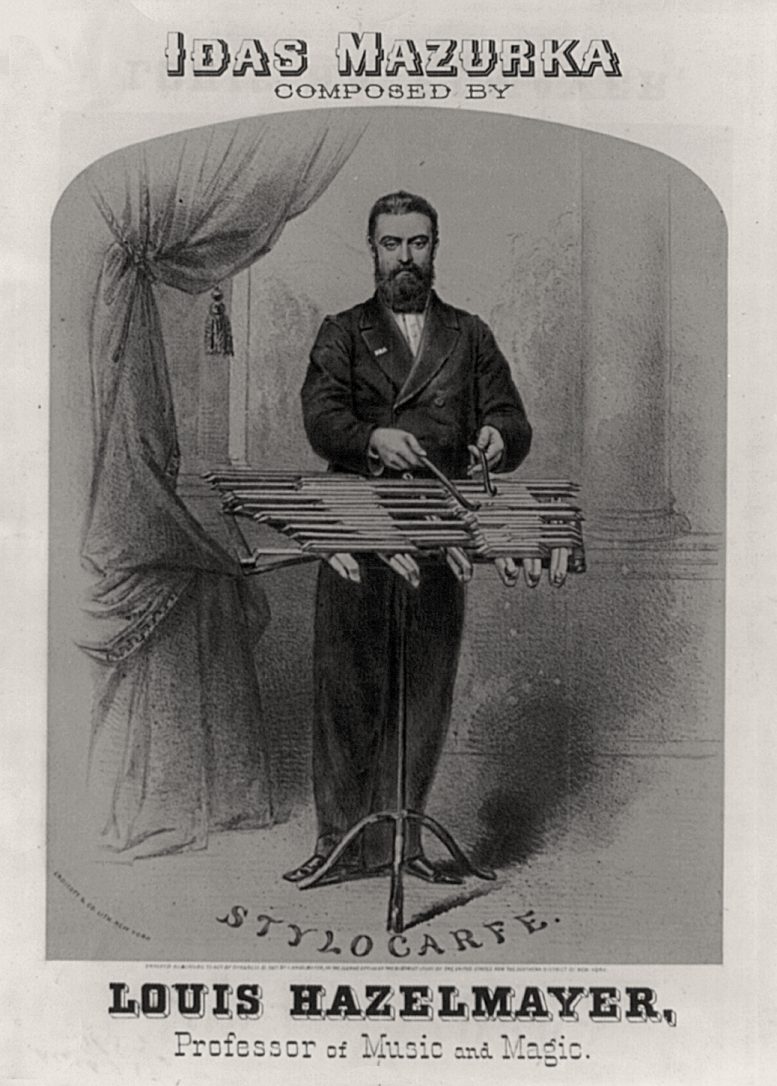
Sheet music cover, c.1868. Library of Congress Prints and Photographs Division Washington, D.C. In English-language regions, Haselmayer’s name was frequently written “Hazelmayer” or “Haslemayer”
In 1868 Haselmayer set off on another foreign tour. This time he was alone, and he took a special piece of luggage with him: it was a percussion instrument that had been especially made for him, resembling a marimba, and Haselmayer had named it “stylocarfe”. From then on, playing the stylocarfe[9] was a fixed part of Haselmayer’s programme. Whether on his major tour that took him across the USA and Canada from 1868 to 1871, or later in Australia, New Zealand, India, South Africa, Honolulu and Hong Kong – wherever he appeared, he always played music in addition to performing magic.
Haselmayer played his own compositions, popular classical pieces, and melodies connected to each location – and he was hugely successful. Many of his compositions were available as sheet music (transcribed for the piano)[10], and the “stylocarfe” was always given special mention in newspaper reviews of the performances. One example is Haselmayer’s guest appearance in Christchurch on a tour of New Zealand in 1872. “The Lyttelton Times” printed a detailed description of the programme: Haselmayer begins his performance with a series of magic tricks and then presents the stylocarfe,
“an instrument of his own invention. He informs the audience that it is made entirely of wood and indiarubber. By the aid of a hammer in each hand he plays to a pianoforte accompaniment with astonishing precision, and being vociferously encored, treats the audience to a medley of national and popular airs. The instrument in some measure resembles the rock harmonicon[11], but Professor Haselmayer can bring much better music out of his stylocarfe than we have ever heard drawn from the former instrument.”[12]
People were also impressed in Adelaide, Australia, where Haselmayer made a number of appearances in the spring of 1873. “The Express and Telegraph” reported that Haselmayer’s magic tricks were “perfect illusions” and “his performances on the most unlikely of all musical instruments ever invented – the Stylocarfe – showed him to possess the soul of a true musician. Out of what appeared to be a bunch of sticks thrown together anyhow, he brought some delicious music, which wonderfully excited the enthusiasm of the audience.”[13]
In South Australia, Haselmayer even went down in history with his stylocarfe. An article published in 1936 in “The Australian Musical News” mentions his performances in Adelaide, and names him among the pioneers of musical life in South-Australia.[14]
“MUSIC! MAGIC! MICE! … and … EDUCATED BIRDS!”
Ludwig Haselmayer’s performances had other peculiar features besides the stylocarfe, though. He was also always accompanied by a flock of little companions: canaries and white mice. The idea of working with canaries might have occurred to Haselmayer on the USA tour with Carl Compars Herrmann, as the latter also had a “bird trick” in his programme: “A large bird cage with canaries is placed on the stage; another is suspended empty at a greater distance over the audience. In an instant the cage on the stage disap- pears without being touched, and the birds are found in the empty cage.”[15]
While the birds were merely “extras” in Compars Herrmann’s trick, Haselmayer turned them into the stars of the show. The New Zealand “Lyttelton Times” wrote that Haselmayer’s success in training them so perfectly was “truly wonderful. They will walk out of their cages and return to them at his bidding, walk up and down ladders, take their respective positions on a swing, stand on their head, rock themselves in a cradle, and perform sundry other manoeuvres that fill the audience with wonderment.”
The white mice were also “extraordinary little creatures. One of them will get into a miniature carriage, while the other yokes itself to the trap and drags it along.”[16]
One mishap here was reported in the New Zealand newspapers in 1872: the white mice escaped on the journey to the performances in Auckland, and so Haselmayer had to find a new “mice ensemble”. “However,” commented “The Auckland Star”, “he is now in the process of training these little animals to various deeds, so it is not unlikely we shall be favoured with an exhibit of the result of his perseverance, tact, and skill.”[17]
Playing the piano with a clothes brush
The musical part of Ludwig Haselmayer’s performances included the “Professor” sitting down at the piano to make a special show out of his playing. Instead of pressing the keys with his fingers, he used a clothes brush – and played the popular “The Carnival of Venice” (“My hat, it has three corners”). “This piece of mastery has never been attempted by any other pianist,”[18] wrote the newspaper “The Queenslander” – “but then,” wrote the “Sydney Punch”, “he is a magician, which all musicians are not.”[19]
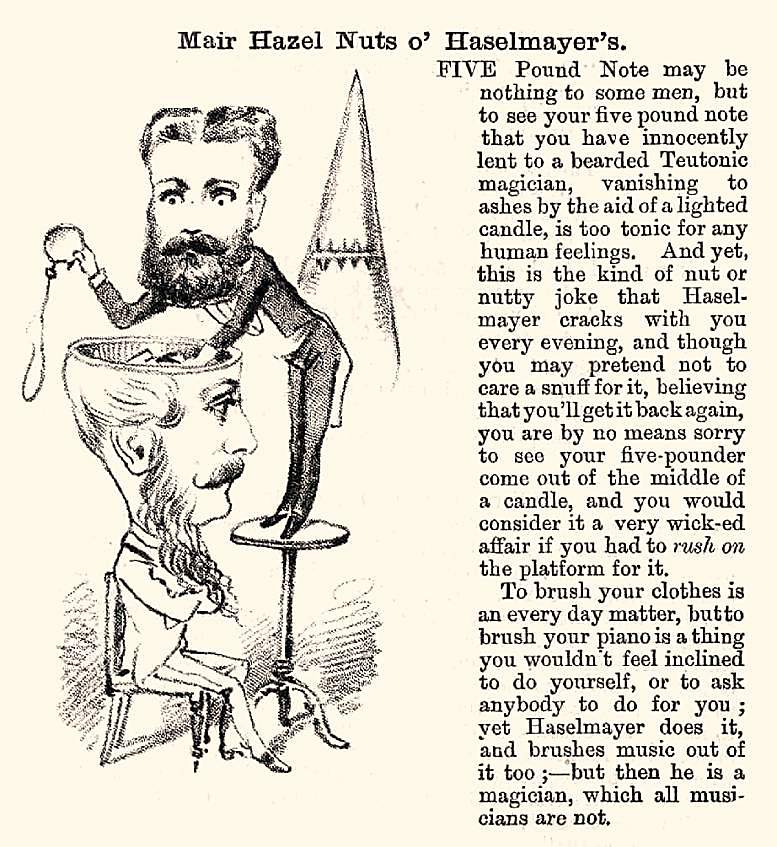
Article on Ludwig Haselmayer in the “Sydney Punch” (27.2.1874, p. 8)
The satirical magazine “Sydney Punch” described another trick as well: Haselmayer asked somebody in the audience for a 5-pound banknote, burned it with a candle, and then “conjured” the banknote out of the ashes again.
Success with advertising
Ludwig Haselmayer had a good understanding of how advertising could work in his favour. He always placed announcements in the newspapers prior to his performances. In the midst of the other advertisements, which were usually small and packed full with writing, Haselmayer’s adverts set themselves apart from the rest with their relatively large letters and brief slogans accentuated with exclamation marks. In addition, he never failed to communicate any positive response from prominent people about his appearances. For instance, when he performed in New Orleans in May 1870, he wrote in a newspaper advertisement that his previous performances in Austin/Texas had been attended by the Governor. Haselmayer emphasised that the Governor had officially declared that Haselmayer was “superior to any performer who has visited the United States”.[20]
When Ludwig Haselmayer advertised his appearances at the Sydney “School of Arts” in August 1881, he naturally mentioned that he would perform the programme that he had presented three weeks earlier on the occasion of the visit by the two princes Edward (Prince Albert Victor Christian Edward of Wales) and George (later King George V) at “Government House”.[21]
In the spring of 1872 Ludwig Haselmayer is reported to have put up “large and attractive ‘posters’”[22] in prominent locations around the city prior to his performances in Christchurch, New Zealand – and he presumably did this elsewhere as well. The poster of “Haselmayer’s Educated Birds” stored at Vienna’s Albertina will probably have been one of these.
Sometimes Haselmayer also attempted another form of outdoor advertising: he arranged for ropes to stretch across a street with lampions and notices attached as advertising for his performances. This certainly attracted attention, although in some places he had to contend with disapproval from the local authorities. In Christchurch, where the ropes were attached across High Street – “so that everyone who passes up and down the thoroughfare cannot fail to notice it”[23] – they had to be removed again a few days later.[24] And in Sydney, where Haselmayer requested approval for attaching a rope with “Chinese lanterns” at a height of about 14 metres above Pitt Street in a letter to the mayor in March 1880, his application was immediately refused.
Madame Haselmayer
In the first half of the 1870s, Ludwig Haselmayer had a large number of performances in Australia and New Zealand, and then went on a relatively long tour across South Africa. Around 1875/1876 he spent some time back in Vienna[25] – and he married a lady whose maiden name was Wilhelmine Weimer[26], but about whose biography not much else is known. According to a report about the couple in the magazine “The Bulletin” published in Sydney, she apparently came from France, but grew up in Vienna and married Ludwig Haselmayer in Budapest.[27]
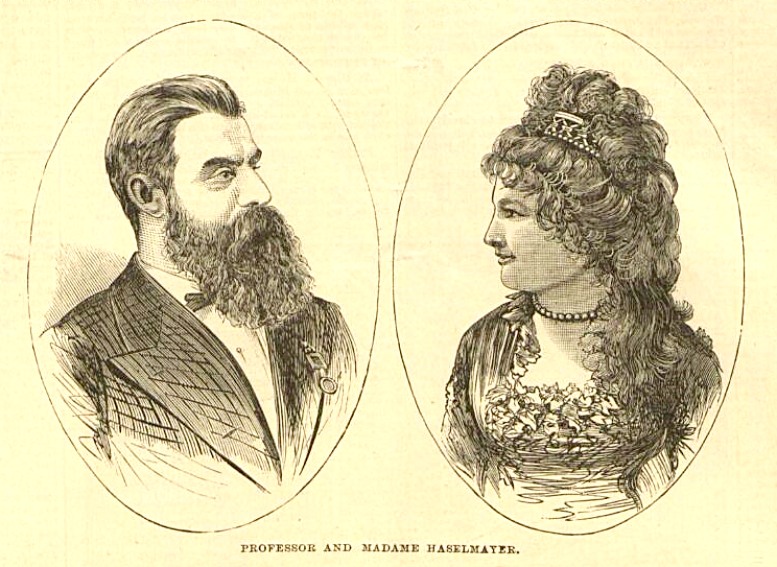
Portrait of Ludwig and Wilhelmine Haselmayer in The Bulletin, 20.3.1880, p. 4
By contrast, the newspapers in Australia and New Zealand reported at length about the Haselmayers when they appeared on stage together. During 1879 the couple gave up their residence in Vienna and went on tour: first to South Africa, and then on to Australia. Their first performance was on 22 March 1880 in the Sydney “School of Arts”, with the proceeds being donated in full to the “Irish Relief Fund” which was collecting donations for the Irish people who were suffering from the famine in their country.
Ludwig Haselmayer drew attention to this fundraiser with effective newspaper advertisements, also mentioning that Madame Haselmayer would appear on stage as well.[28] “Crystal Cabinet Feat” was the name of the trick – it had “puzzled thousands in Vienna, Paris, and throughout Cape Colony”. Anybody who could replicate the feat was promised 100 pounds as a reward.
No information has been found on performances by Wilhelmine Haselmayer in Vienna, Paris and South Africa. However, in Australia and subsequently in New Zealand, the “Crystal Cabinet Feat” took audiences by storm. It was an escape trick that was usually described in detail in the reviews of Haselmayer’s programme. “The ‘Crystal Cabinet’ is a remarkably clever invention,” wrote the Melbourne newspaper “The Weekly Times”, for example:
“It is a box resting on four small feet, about a foot from the floor of the stage. The top and bottom are of wood, and the sides of plate glass. Into this the lady is placed in a kneeling position, with her wrists resting in a pair of small stocks, which are fastened with padlocks by two persons selected by the audience. The box is then locked, and covered for perhaps thirty seconds with a silken cloth, and at the end of that time Madame Haselmayer reappears upon the stage. The box is turned up and examined in view of the audience, but all the fastenings are found intact. There is no lowering of lights, or any of the usual artifices resorted to, so that from its very simplicity the trick is an uncommonly clever one.”[29]
A new kind of entertainment
For this second major world tour, Ludwig Haselmayer developed a new programme. Besides the music section, his bird and mice tricks were the only parts of his previous performances to be repeated. “The Weekly Times” praised that “in his new entertainment of magic and mystery” Haselmayer had “abandoned the conventional lines within which the majority of prestidigitators confine themselves; and in place of the tiresome card, box, hat, and money tricks, and countless escamoterie in which they revel, he uses clever mechanical and electrical machines”.[30]
One of the amazing new elements of Haselmayer’s programme was the card-trick automaton “Psycho”, a puppet about 60 cm high that played a game of whist with three members of the audience. Psycho sat on a wooden box on top of a glass cylinder. His cards were laid out in front of him, and when it was his turn, Psycho picked up the required card with his right hand, accompanied by suitable gestures: “The movements of the figure in imitated meditation, the air of relief with which it lets its head drop when the card is played, were an excellent burlesque, and as amusing as the skill with which it played the game was bewildering.”[31]
However, Psycho was not invented by Ludwig Haselmayer, but instead by the English magician John Nevil Maskelyne. The latter presented the automaton in 1875 in London and caused quite a stir. Presumably Haselmayer saw the original Psycho[32] during his stay in Europe in the late 1870s and had one made for his own use.
The final part of Haselmayer’s performance, “Electric Spark Illuminations”, delighted his audiences. It was described in detail in newspaper reviews:
“A very powerful battery capable of emitting a spark 50 centimeters in length, is connected with vacuum tubes of different designs, filled with hydrogen gas, salts of phosphorous, and other chemical-compounds. The current rushing through the tubes and in contact with the several substances produces intensely brilliant and beautiful colours, closing with the illumination of one set of tubes, nearly 30ft. long, formed into the motto, ‘God Save the Queen’.”[33]
Disregarded in Austria, stardom in Australia
Between 1880 and 1882 Ludwig and Wilhelmine Haselmayer went on extensive tours across Australia and New Zealand. In the spring of 1883 the two travelled around Thailand and China[34], and after that they performed in Nagasaki, Japan, in May 1883[35]. Then they continued on to India, where they performed in numerous cities until the spring of 1884[36]. Unfortunately, Ludwig Haselmayer contracted malaria during his tour of India[37]. He cancelled all further appearances and travelled to Vienna, where he owned a house in Dornbach (which was still just outside the city at the time). On 19 April 1885 he died there from his illness at the age of 45, and was buried at Dornbach cemetery[38].
Apart from the “Educated Birds” poster in Vienna’s Albertina, there seems to be a total lack of any memories of this successful magician in the city of his birth. Even during his lifetime, however, he was little known in Vienna: besides announcements of his early appearances, there are merely a few brief references in Viennese newspapers, and his events in other European cities were not mentioned in Vienna either. The situation was very different outside Europe, especially in Australia and New Zealand where long articles were written about him. These numerous reports deliver many detailed accounts of his appearances.
Ludwig Haselmayer planned his career cleverly and strategically, and he knew where and how to be successful: audiences developed a much greater appreciation of magicians over the course of the 19th century. Moving away from its association with travelling artists, magic had developed into a socially acceptable stagecraft. An increasing range of technology enabled new, elaborate tricks and turned the appearances into illusion shows. They drew large audiences, and so in Europe there was fierce competition for audiences among the magicians. By contrast, these new forms of popular entertainment were relatively new to Australia and New Zealand. Haselmayer was therefore able to offer audiences new experiences that had never been seen before – especially as he not only performed in the major cities, but also travelled to more remote areas. This effort was greatly appreciated – the “Lyttelton Times” in New Zealand, for instance, wrote that although the card-playing automaton Psycho was not Haselmayer’s idea: “Professor Haselmayer deserves great credit for introducing ‘Psycho’ to this part of the world”.[39]
Incidentally, Ludwig Haselmayer – who spoke (as one newspaper noted) “delightful, broken English”[40] – became a famous name. The “Sydney Punch” went even further by declaring (with an English pronunciation of Haselmayer’s name): “The most popular Mayor in Sydney – Haselmayer”.[41]

Denscher, Barbara: “Haselmayer’s Educated Birds”. A poster and its background, in: Viennese Posters. Art, Artists, Artwork. 1868–1938. Aesculus Verlag, Wolkersdorf 2022, p. 13ff.
Translation: Rosemary Bridger-Lippe
[1] The Ottawa Free Trader, 24.12.1870, p. 1.
[2] Pfarre Wien-Atzgersdorf, register of baptisms 1835–1843 (shelf mark 01-07), p. 97.
[3] Anton Varry (1813–1862, real name Anton Löger) was an actor, journalist and playwright. “Varry’s Liederspielhalle”, which was founded by him, gave their first performance on 11 April 1860 in the entertainment room of the Viennese coffeehouse “Ungers Casino” and subsequently appeared at other renowned Viennese entertainment establishments such as “Zum Sperl”, “Drehers Etablissement” and “Schwender”. They were very successful at first and gave numerous performances in Vienna in the years 1860–61. Before long, however, the audience lost interest and the “Liederspielhalle” was disbanded in the spring of 1862. The “Wiener Theater-Chronik” (25.9.1862, p. 155) wrote in the obituary for Anton Varry, who died on 15 September 1862, that the “Liederspielhalle” “was initially very well received, but when the Viennese heard almost nothing but songs, they soon grew tired of them because they wanted to laugh out loud over their beer, and Varry did too little for them in that respect.”
[4] Haselmayer’s trick is described in detail in the New Zealand newspaper “The Lyttelton Times”, 4.4.1872, p. 2.
[5] By the time “Varry’s Liederspielhalle” was disbanded in the spring of 1862, Ludwig Haselmayer had appeared there several times, and afterwards he continued to appear at various Viennese entertainment venues (see for example: Der Zwischen-Akt, 1.12.1862, p. 12, performance at “Zum großen Zeisig”; Fremden-Blatt, 12.3.1864, p. 19, performance at “Schwender”).
[6] The term “prestidigitateur”, meaning a conjuror, was adopted from the French in the 19th century and was used frequently even in the early 20th century. Its synonym and a term that was also used frequently at the time, “escamoteur”, was also a French word.
[7] Baltimore Wecker, 14.11.1865, p. 3.
[8] Baltimore Wecker, 15.11.1865, p. 3.
[9] The origin of the name “stylocarfe” could not be found.
[10] For instance, in 1870 the sheet music for several compositions by Ludwig Haselmayer was published by the music publisher Armand Blackmar in New Orleans. A copy of one piece, “Aerial Bell Polka”, has been preserved in the collection of the Library of Congress.
[11] The “rock harmonicon” or “stone xylophone” was a popular instrument in the 19th century, particularly in English-speaking regions. Its tuned bars were made of stone.
[12] The Lyttelton Times, 4.4.1872, p. 2.
[13] The Express and Telegraph, 22.1.1873, p. 3.
[14] Brewster-Jones, H.: Pioneers and Problems. South Australia’s Musical History. In: The Australian Musical News, 1.10.1936, p. 28.
[15] New York Herald, 16.9.1865, p. 4.
[16] The Lyttelton Times, 4.4.1872, p. 2.
[17] The Auckland Star, 12.2.1872, p. 2.
[18] The Queenslander, 4.6.1874, p. 1.
[19] Sydney Punch, 27.2.1874, p. 8.
[20] New Orleans Republican, 13.5.1870, p. 5.
[21] cf. The Bulletin, 13.8.1881, p. 15.
[22] The Lyttelton Times, 1.4.1872, p. 2.
[23] Ibid.
[24] The Lyttelton Times, 9.4.1872, p. 3. Haselmayer’s advertising had to be removed at the request of a city councillor because some time earlier “the request of M. Fleury to erect a signboard over the footpath was disallowed, and he thought that everybody should be treated alike”.
[25] In the Vienna address book “Adolph Lehmann’s allgemeiner Wohnungs-Anzeiger”, Haselmayer is listed in 1876 (4th district, Wohllebeng. 14), 1877 (Penzing, Parkg. 66), and in 1878 and 1879 (7th district, Kaiserstr. 17).
[26] Wilhelmine Weimer is mainly referred to as “Madame Haselmayer” in the sources. Her maiden name is found in a note in the magazine “The Argus” published in Melbourne (16.7.1881, p. 1.).
[27] The Bulletin, 20.3.1880, p. 4.
[28] cf. The Sydney Daily Telegraph, 22.3.1880, p. 4.
[29] The Weekly Times, 11.9.1880, p. 17.
[30] The Weekly Times, 11.9.1880, p. 17.
[31] The Ballarat Star, 12.11.1880, p. 3.
[32] The original Psycho has been preserved in the Museum of London since 1934.
[33] The Weekly Times, 11.9.1880, p. 17.
[34] cf. The Hongkong Telegraph, 3.3.1883, p. 2.
[35] cf. The Hongkong Telegraph, 29.5.1883, p. 2.
[36] cf. e.g. The Times of India, 11.12.1883, p. 3; and The Lorgnette, 27.3.1884, p. 4.
[37] cf. Australian Variety Theatre Archive, Practitioners, Professor Louis Haselmayer. Popular Culture Entertainment: 1850–1930.
[38] Pfarre Wien-Dornbach, register of deaths 1874–1898 (shelf mark 03-07), p. 72. The stated cause of death is “lung oedema”.
[39] The Lyttelton Times, 23.12.1880, p. 5.
[40] Oamaru Mail, 16.12.1880, p. 2.
[41] Sydney Punch, 20.3.1874, p. 3.
